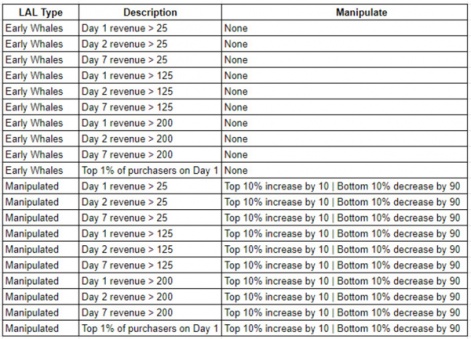This is the third of three articles from Brian Bowman, the CEO of Consumer Acquisition.
In the first and second segments of this series, we did our
Now it’s time to optimize what we’ve got and make it even better.
Audience Expansion, Creative Testing, and Creative Refresh
These are the three fronts we’ll tackle to optimize this campaign
- Audience expansion
Once again, we’ll fire up our Audience Builder Express tool and start isolating specific audiences. In addition to the standard in-app event audiences (registrations, payers, etc), we’ll build, and test audiences based on these KPIs:
- Spend - all time
- Last 7 days spend
- Last 30 days spend
- First activity date
- Last activity date
- Last spend date
- First spend date
- Spend in first 7 days
- Spend in first 30 days
- Highest level
- Value based audience by setting minimum value
- Split by Android and iOS and select individual countries
This is what it looks like as you build up your player base. As the data accrues, you'll be able to build manipulated audiences like this.


A little bit later on, as your title continues to grow, you can build even more audiences focused on users who pay early and pay a lot:

Great creative takes a lot of work to develop, so we want it to last as long as possible.
We also want to find every single person on the planet who could be a high-value customer. So we very carefully expand audiences to avoid audience fatigue as much as we do it to avoid creative fatigue.
But being able to tie these audiences and rotate through them means our creative lasts significantly longer.
It allows us to find a huge potential customer base, and we get thousands of conversions we might never have found or would have spent way too much to get.
Our creative development work is about 20% concepts and 80% variations.
Being able to control and expand audiences like this will also be valuable later on, as we scale up and the spending goes up, because audiences burn out even faster as campaigns scale.
Exploiting every possible audience expansion trick, at every step of the campaign, is critical. Being able to do it efficiently and effectively is a massive competitive advantage.
- Creative testing
Just as audiences burn out faster with high-velocity campaigns, creative burns out faster, too, of course. So we have to be aggressively testing all the time. And we do: we are constantly rotating through new creative.
To find creative that performs at the level we need, we usually have to test twenty ads to find one piece of creative good enough to replace a control.
That means we need a constant stream of new creative – both new “concepts” (completely new, out-of-the-box creative approaches) and new ad variations.
Our creative development work is about 20% concepts and 80% variations.
This creative testing machine is running all the time, fueled by creative from our Creative Studio. It has enough capacity to easily deliver the 20 ads we need per week and can handle delivering up to hundreds of ads every week.
Because the game is global by this point, we’ll also need localized creative assets. Creative has to be in the right language and may even be optimized for localized placements or cultures.
So we don’t need just one winning ad every week: we need that winning ad cloned into every language and optimized for every region.
Of course, all those ads also have to be at the right aspect ratios and optimized for Facebook’s 14 different ad placements. That’s when creative development gets really work-intensive. But the Creative Studio can handle that. They’re adept at creating all those variations efficiently.
All those ads have to be at the right aspect ratios and optimized for Facebook’s 14 different ad placements. That’s when creative development gets really intensive.
That’s the creative development side. There’s also a huge amount of testing strategy required to grow campaigns like this.
First, we have to decide when and how we’re going to use Dynamic Language Optimization, and when and how we’ll use Direct Language Targeting. These two levers can make a nice difference in campaign performance, but they don’t always work. Or sometimes they need tweaks to work well.
We’ll also test worldwide versus country clusters, optimizing for large populations based on the dominant language of those populations.
With dozens of countries and at least a dozen languages in play, this gets complicated. Fortunately, we have tools that make sorting all these inputs easy. And it is worth the work. Matching the right ad, language, and country cluster can improve performance by 20% or more.
- Creative refresh
Even with all the creative development and all the audience expansion tricks, creative is still going to get stale. So we have to be slowly rotating new, high-performance creative into ad sets all the time.
We don’t just stop showing one piece of creative and jump over to the new ad.
As you probably know, even if a new ad tests well, it doesn’t mean it will beat the control. So, we do careful “apples to apples” creative tests to ramp up new assets.
New Concept
Variation
Refresh
Conclusion
So that’s how we’re launching new gaming apps on Facebook using their newest best practice, structure for scale.
This process is working well and we’re constantly testing, tweaking and enhancing it.
That’s the fun thing about user acquisition on Facebook: It’s constantly evolving.
The article we’ll write for how to launch a gaming app in 2020 Q4 (and even Q1) will be different from what you’ve just read.





















